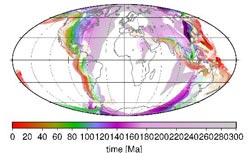Magnetic field, mantle convection and tectonics

Berechnete gegenwärtige Wärmestromverteilung an der Kern-Mantel-Grenze
These are the research results presented by a group of geoscientists in the new advance edition of “Nature Geoscience” on Sunday, July 29th. The results show how the rapid processes in the outer core, which flows at rates of up to about one millimeter per second, are coupled with the processes in the mantle, which occur more in the velocity range of centimeters per year.
The international group of scientists led by A. Biggin of the University of Liverpool included members of the GFZ German Research Centre for Geosciences, the IPGP Paris, the universities of Oslo and Utrecht, and other partners.
It is known that the Earth's magnetic field is produced by convection currents of an electrically conducting iron-nickel alloyin the liquid core, about 3,000 kilometers below the earth's surface. The geomagnetic field is highly variable, there are changes in Earth's magnetic field on a multitude of spatial and temporal scales. Above the liquid outer core is the mantle, the rock in which behaves plastically deformable due to the intense heat and high pressure.
At the boundary between Earth's core and mantle at 2900 km depth there is an intense heat exchange, which is on the one hand directed from the Earth's core into the mantle. On the other hand, processes within Earth's mantle in turn also affect the heat flow. The interesting question is how the much slower flow in the solid mantle influences the heat flow and its spatial distribution at the core-mantle boundary, and how this will affect the Earth's magnetic field which is produced due to the much faster currents in the Earth's core.
/Key variable heat transfer/
“The key variable is the heat flow. A cooler mantle accelerates the flow of heat from the hot core of the Earth, and in this way alters the also heat-driven convection in the Earth's core”, said Bernhard Steinberger of the GFZ German Research Centre for Geosciences. “Ocean floor sinking into the mantle due to tectonic processes can lead to cooling in the mantle. They cause at these sites an increased heat flow into the cooler parts, namely until they have been heated to the ambient temperature.” That might take several hundred million years, however.
Conversely, the hot core of the Earth leads to the ascent of heated rocks in form of large bubbles, so-called mantle plumes that separate from the core-mantle boundary and make their way up to the surface of the earth. This is how Hawaii came into existence. This increases the local heat flux out of the earth's core and in turn modifies the generator of the geomagnetic field.
/Reversals of the magnetic field/
In the Earth's history, polarity reversals of the geomagnetic field are nothing extraordinary. The most recent took place only 780 000 years ago, geologically speaking a very short period of time. The research team was able to determine that in the period of 200 to 80 million years before present, reversals initially happened more often, namely up to ten times in hundred million years. “Surprisingly, these reversals stopped about 120 million years ago and were absent for nearly 40 million years,” explains GFZ scientist Sachs. Scientists presume that the reason for this is a concurrent reorientation of the whole mantle and crust with a shift in the geographic and magnetic poles of about 30°. Known as “true polar wander”, thisprocess is caused by a change in density distribution in the mantle. If it increases the heat flux in equatorial regions, it would presumably lead to more frequent field reversals, if it decreases it, the field reversal might not occur.
/Looking to the future/
According to current knowledge, therefore, an influence of plate tectonics and mantle convection on the Earth's magnetic field seems quite possible. The article also shows, however, that further research is still needed for a better understanding of these relationships. In particular, more episodes of “true polar wander” should be derived from paleomagnetic data, and it should be determined whether these are usually associated with an altered behavior of the magnetic field (e.g. frequency of field reversal). Also, future models for the generation of the geomagnetic field should investigate the influence of the spatial and temporal variation of the heat flux at the core-mantle boundary in more detail.
J. Biggin et al., “Possible links between long-term geomagnetic variations and whole-mantle convection processes”, Nature Geoscience, Vol. 5, August 2012, doi:10.1038/NGEO1521
Images in printable resolution and an animation can be found at: http://www.gfz-potsdam.de/portal/gfz/Public+Relations/M40-Bildarchiv/Magnetfeld_Waermefluss
contact : Dr. Bernhard Steinberger, +49-331-288 1881
Media Contact
All latest news from the category: Earth Sciences
Earth Sciences (also referred to as Geosciences), which deals with basic issues surrounding our planet, plays a vital role in the area of energy and raw materials supply.
Earth Sciences comprises subjects such as geology, geography, geological informatics, paleontology, mineralogy, petrography, crystallography, geophysics, geodesy, glaciology, cartography, photogrammetry, meteorology and seismology, early-warning systems, earthquake research and polar research.
Newest articles

Superradiant atoms could push the boundaries of how precisely time can be measured
Superradiant atoms can help us measure time more precisely than ever. In a new study, researchers from the University of Copenhagen present a new method for measuring the time interval,…

Ion thermoelectric conversion devices for near room temperature
The electrode sheet of the thermoelectric device consists of ionic hydrogel, which is sandwiched between the electrodes to form, and the Prussian blue on the electrode undergoes a redox reaction…

Zap Energy achieves 37-million-degree temperatures in a compact device
New publication reports record electron temperatures for a small-scale, sheared-flow-stabilized Z-pinch fusion device. In the nine decades since humans first produced fusion reactions, only a few fusion technologies have demonstrated…





















